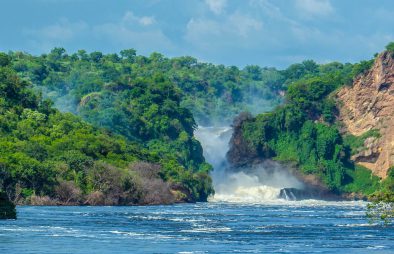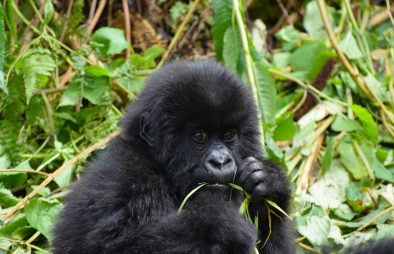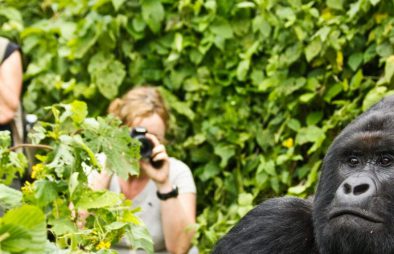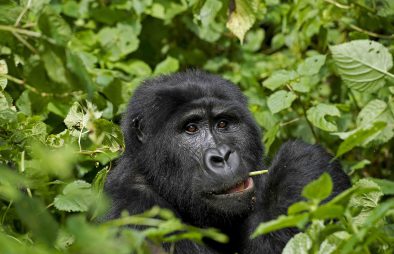Gorilla Conservation in Uganda, Rwanda & DR Congo
Years of daily gorilla conservation through direct and sustained protection has saved endangered and critically endangered Great Apes from extinction and stabilizing their already threatened population. Of all the four sub-species of gorillas, the mountain gorillas have the most successful and effective conservation strategies, although these similar methods have been extended to save the nearby Eastern lowland gorillas (Gorilla beringei graueri) that are now experiencing substantial decline. The Cross River Gorillas in Nigerian and Cameroon and western lowland gorillas are critically endangered while the remaining two gorilla sub-species are endangered and face consequential threats to their survival although daily conservation efforts are implored.
Interestingly, gorillas have for the last 5 decades been the flagship species of World Wildlife Fund for nature (WWF) through the “African Great Apes Programme”. Their main conservation works protect all the four gorilla sub-species through increasing support for gorilla conservation among local and International communities, improving the effectiveness of Gorilla National Parks as well as minimizing illegal trade of Gorilla products. Surprisingly, these Gorilla Conservation Programs not only work to protect gorillas alone but also the many flora and fauna species in the gorilla natural habitats.
The United Nations Environment Programme (UNEP) and United Nations Educational, Scientific and Cultural Organization (UNESCO) also undertake the Great Apes Survival Partnership (GRASP) programs where all the four gorilla sub-species as well as their natural habitats are protected. They conduct campaigns in different countries. Different initiatives are encouraged such as calling upon nature lovers from across the world to trek gorillas because it is from these treks that local communities also benefit directly, giving a gift where Gamba Complex (home to western lowland gorillas) is protected, buying and using sustainable wood to protect gorilla habitats and donating to Organizations undertaking Gorilla conservation.
Conservation projects for Mountain Gorillas
The most popular Conservation initiatives for mountain gorillas were pioneered by Dian Fossey who through her works in the 1960s established Karisoke Research Center. This came along with habituation of mountain gorillas to get accustomed to human presence and this she did to closely observe and document gorilla behaviors, movements and status among others. Today, the Dian Fossey Fund (set up after Dian Fossey’s death and to continue with her legacy) comprises of trackers, researchers and Rangers under Rwanda Development Board. The Dian Fossey Fund has also dedicated anti-poaching teams that patrol different sectors of gorilla habitats to offer protection against illegal activities such as poaching and habitat encroachment. The International Gorilla Conservation Programme (IGCP) also secures the future for mountain gorillas by forming coalition of International Conservation Organizations, National and local partners to ensure the long-term survival of endangered mountain gorillas. These collaborations go across the three countries (Rwanda, Democratic Republic of Congo and Uganda) with improved social and political support for conservation, pioneering tourism revenue-sharing schemes among surrounding communities in addition to elevating effectiveness in the managements of the National Parks sheltering mountain gorillas.
Conservation initiatives for Eastern Lowland Gorillas
Besides mountain gorillas, the Gorilla Fund also contributes to the conservation of Eastern Lowland Gorillas that have unfortunately not been protected or studied outside Kahuzi-Biega National Park. These largest gorilla species are one of the 25 most endangered primates of the World with over 80% of their population extinct in the last two decades. Given the fact that majority of the Eastern lowland Gorillas find shelter outside their designated Protected Areas, thus making it important to engage local communities in different conservation efforts. A research and Conservation Field Station was established in Nkuba Village, at the boundary of a verdant forest and it is where these gorillas are habituated, tracked and studied.
Conservation of Western Lowland Gorillas
The western lowland gorillas are also facing tremendous decline resulting from increased access to their once secluded habitats, poaching, diseases such as Ebola, weak law enforcement and corruption. Because of this, regional conservation initiatives are being used to protect these creatures that are said to be critically endangered. There has been increased collaboration with private sector in minimizing negative effects of extractive industry on these Giant Apes, setting up of agro-industries (rubber and palm oil) to make way for crops that have less effect on gorillas and their habitats.
They World Wildlife Fund for nature through the African Great Apes Programme is also active in engaging different conservation measures such as strengthening Protected Areas that shelter these gorillas, supporting gorilla trekking tours in the different Parks, adapting the human Ebola vaccine that will also save gorillas and promoting sustainable development of Parks in the Dzanga Sangha Protected Area Complex among others. You and I also have a responsibility in conserving these gorillas that include donating to WWF, using sustainable fuel options, booking gorilla safaris and spreading the gospel of gorilla conservation.
Conservation of Cross River Gorillas
The African Conservation Foundation joins other International and regional Organizations such as WWF in saving Cross River Gorillas of Nigeria and Cameroon from extinction. The Cross River Gorilla Conservation Programme for instance provides long term security to these critically endangered gorillas by mainly implementing community-based management strategies. A number of steps that include establishing of new Gorilla Parks/Reserves in the two countries, supporting monitoring efforts of these gorilla sub-populations in the main forest areas, delivering effective conservation education strategies and supporting the development of sustainable livelihoods as well as economic development initiatives and gorilla research are currently on-going.




